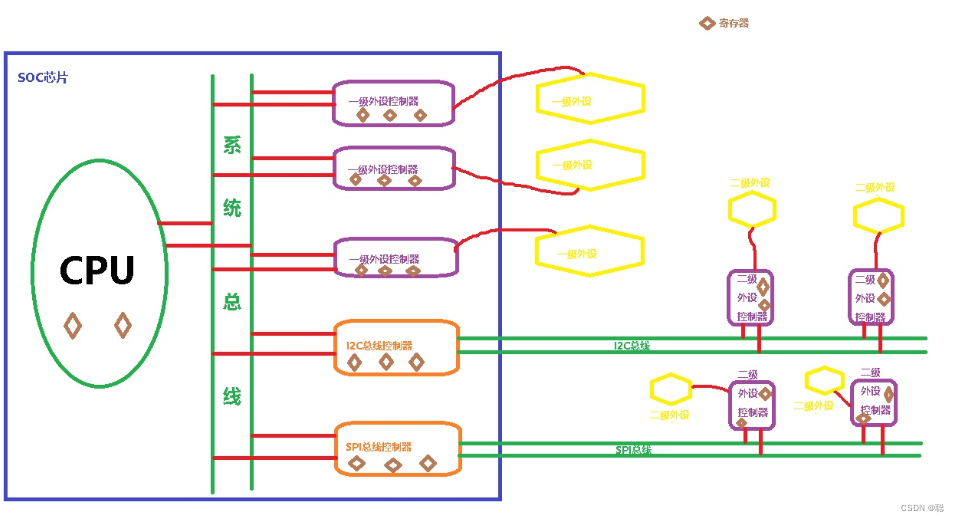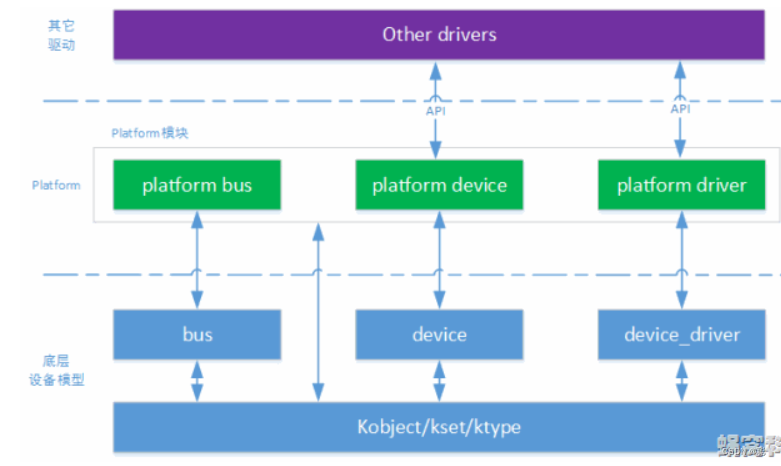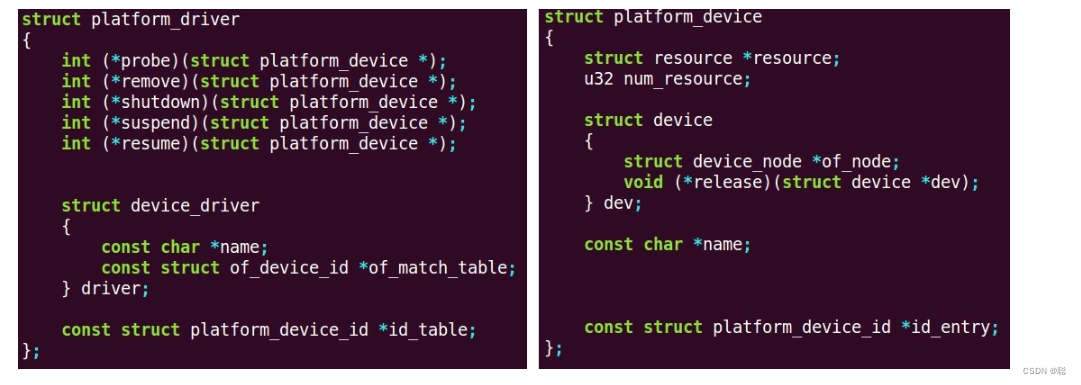一、总线、设备、驱动
硬编码式的驱动开发带来的问题:
-
垃圾代码太多
-
结构不清晰
-
一些统一设备功能难以支持
-
开发效率低下
1.1 初期解决思路:设备和驱动分离

struct device来表示一个具体设备,主要提供具体设备相关的资源(如寄存器地址、GPIO、中断等等)
struct device_driver来表示一个设备驱动,一个驱动可以支持多个操作逻辑相同的设备
带来的问题-------怎样将二者进行关联(匹配)?
硬件上同一总线上的设备遵循一致的时序通信,在其基础上增加管理设备和驱动的软件功能
于是引入总线(bus),各种总线的核心框架由内核来实现,通信时序一般由SOC供应商支持
内核中用struct bus_type来表示一种总线,总线可以是实际存在的总线,也可以是虚拟总线:
-
实际总线:提供时序通信方式 + 管理设备和驱动
-
虚拟总线:仅用来管理设备和驱动(最核心的作用之一就是完成设备和驱动的匹配)
理解方式:
设备:提供硬件资源——男方
驱动:提供驱动代码——女方
总线:匹配设备和驱动——婚介所:提供沟通机制,完成拉郎配
1.2 升级思路:根据设备树,在系统启动时自动产生每个节点对应的设备
初期方案,各种device需要编码方式注册进内核中的设备管理结构中,为了进一步减少这样的编码,引进设备树
二、基本数据类型
2.1 struct device
struct device
{struct bus_type *bus; //总线类型dev_t devt; //设备号struct device_driver *driver; //设备驱动struct device_node *of_node;//设备树中的节点,重要void (*release)(struct device *dev);//删除设备,重要//.......
};
2.2 struct device_driver
struct device_driver
{const char *name; //驱动名称,匹配device用,重要struct bus_type *bus; //总线类型struct module *owner; //模块THIS_MODULE const struct of_device_id *of_match_table;//用于设备树匹配 of_match_ptr(某struct of_device_id对象地址) 重要//......
};
struct of_device_id
{char name[32];//设备名char type[32];//设备类型char compatible[128]; //用于device和driver的match,重点
};
//用到结构体数组,一般不指定大小,初始化时最后加{}表示数组结束
三、platform总线驱动
platform是一种虚拟总线,主要用来管理那些不需要时序通信的设备
基本结构图:
3.1 核心数据类型之platform_device
struct platform_device {const char *name; //匹配用的名字int id;//设备id,用于在该总线上同名的设备进行编号,如果只有一个设备,则为-1struct device dev; //设备模块必须包含该结构体struct resource *resource;//资源结构体 指向资源数组u32 num_resources;//资源的数量 资源数组的元素个数const struct platform_device_id *id_entry;//设备八字 };
struct platform_device_id
{char name[20];//匹配用名称kernel_ulong_t driver_data;//需要向驱动传输的其它数据
};
struct resource
{resource_size_t start; //资源起始位置 resource_size_t end; //资源结束位置const char *name; unsigned long flags; //区分资源是什么类型的
};#define IORESOURCE_MEM 0x00000200
#define IORESOURCE_IRQ 0x00000400
/*
flags 指资源类型,我们常用的是 IORESOURCE_MEM、IORESOURCE_IRQ 这两种。start 和 end 的含义会随着 flags而变更,如
a -- flags为IORESOURCE_MEM 时,start 、end 分别表示该platform_device占据的内存的开始地址和结束值;注意不同MEM的地址值不能重叠
b -- flags为 IORESOURCE_IRQ 时,start 、end 分别表示该platform_device使用的中断号的开始地址和结束值
*/
/***注册:把指定设备添加到内核中平台总线的设备列表,等待匹配,匹配成功则回调驱动中probe;*/init 函数
int platform_device_register(struct platform_device *);
/***注销:把指定设备从设备列表中删除,如果驱动已匹配则回调驱动方法和设备信息中的release;*/
void platform_device_unregister(struct platform_device *);
获取资源*led设备驱动会用到
struct resource *platform_get_resource(struct platform_device *dev,unsigned int type, unsigned int num); /*功能:获取设备资源参数:dev:平台驱动type:获取的资源类型num:对应类型资源的序号(如第0个MEM、第2个IRQ等,不是数组下标)返回值:成功:资源结构体首地址,失败:NULL */
3.2 核心数据类型之platform_driver
struct platform_driver
{匹配和卸载int (*probe)(struct platform_device *);//设备和驱动匹配成功之后调用该函数int (*remove)(struct platform_device *);//设备卸载了调用该函数void (*shutdown)(struct platform_device *);int (*suspend)(struct platform_device *, pm_message_t state);int (*resume)(struct platform_device *);struct device_driver driver;//内核里所有的驱动必须包含该结构体const struct platform_device_id *id_table; //能够支持的设备八字数组,用到结构体数组,一般不指定大小,初始化时最后加{}表示数组结束
};
int platform_driver_register(struct platform_driver*pdrv); /*功能:注册平台设备驱动参数:pdrv:平台设备驱动结构体返回值:成功:0失败:错误码 */ void platform_driver_unregister(struct platform_driver*pdrv);
四、platform的三种匹配方式
2.1 名称匹配:一个驱动只对应一个设备 ----- 优先级最低
2.2 id匹配(可想象成八字匹配):一个驱动可以对应多个设备 ------优先级次低
device模块中,id的name成员必须与struct platform_device中的name成员内容一致
因此device模块中,struct platform_device中的name成员必须指定
driver模块中,struct platform_driver成员driver的name成员必须指定,但与device模块中name可以不相同
2.3 设备树匹配:内核启动时根据设备树自动产生的设备 ------ 优先级最高
使用compatible属性进行匹配,注意设备树中compatible属性值不要包含空白字符
id_table可不设置,但struct platform_driver成员driver的name成员必须设置
五、名称匹配之基础框架
/*platform device框架*/ #include <linux/module.h> #include <linux/kernel.h> #include <linux/init.h> #include <linux/platform_device.h>//定义资源数组 //设备退出时候会调用 static void device_release(struct device *dev) {printk("platform: device release\n"); }struct platform_device test_device = {.id = -1,.name = "test_device",//必须初始化.dev.release = device_release, };static int __init platform_device_init(void) {platform_device_register(&test_device);return 0; }static void __exit platform_device_exit(void) {platform_device_unregister(&test_device); }module_init(platform_device_init); module_exit(platform_device_exit); MODULE_LICENSE("Dual BSD/GPL");
/*platform driver框架*/
#include <linux/module.h>
#include <linux/kernel.h>
#include <linux/init.h>
#include <linux/platform_device.h>static int driver_probe(struct platform_device *dev)
{printk("platform: match ok!\n");return 0;
}static int driver_remove(struct platform_device *dev)
{printk("platform: driver remove\n");return 0;
}struct platform_driver test_driver = {.probe = driver_probe,.remove = driver_remove,.driver = {.name = "test_device", //必须初始化},
};static int __init platform_driver_init(void)
{platform_driver_register(&test_driver);return 0;
}static void __exit platform_driver_exit(void)
{platform_driver_unregister(&test_driver);
}module_init(platform_driver_init);
module_exit(platform_driver_exit);
MODULE_LICENSE("Dual BSD/GPL");
设备中增加资源,驱动中访问资源



技术是如何赋能数字化营销生态的?- 我为什么要翻译介绍美国人工智能科技巨头IAB公司)


)













